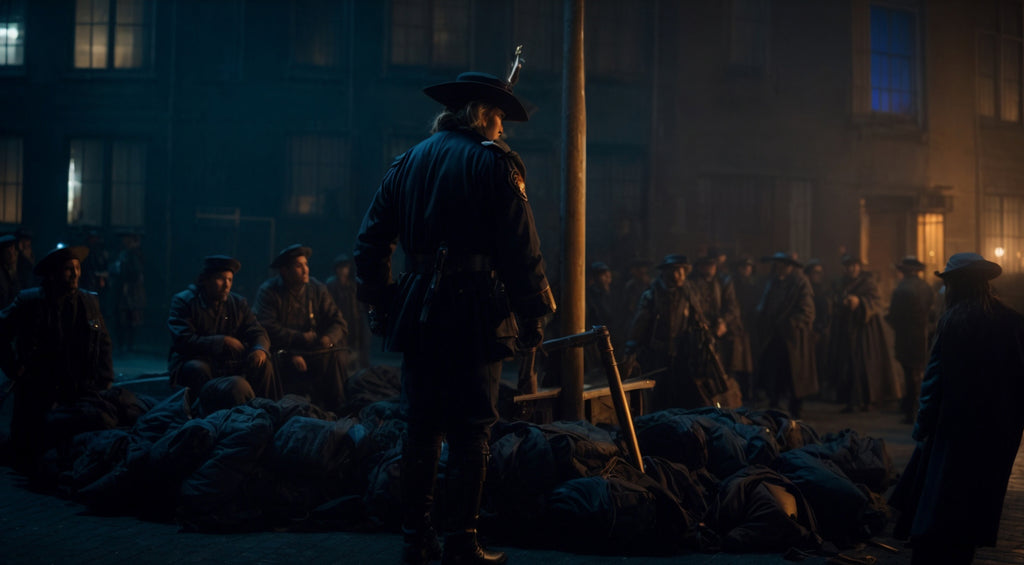In the vast tapestry of art history, few canvases rival the grandeur and significance of Rembrandt van Rijn's masterpiece, "The Night Watch." A symphony of human creativity, this 17th-century painting transcends time, capturing the essence of Amsterdam's Golden Age with unparalleled depth and emotion. However, as the relentless march of technology presses forward, artificial intelligence (AI) now offers its own interpretation of this iconic work—a stark juxtaposition that illuminates the complexities of human vs. AI creation.
Human Interpretation
Rembrandt's "The Night Watch" is a triumph of artistic vision and skill. Set against the backdrop of 17th-century Amsterdam, it portrays a group of civic guardsmen led by Captain Frans Banninck Cocq and his lieutenant, Willem van Ruytenburch. Rembrandt's masterful brushwork infuses each figure with life and personality, capturing their individual expressions and interactions with unparalleled depth. The play of light and shadow adds drama and intensity to the scene, transforming a routine group portrait into a captivating narrative brimming with tension and camaraderie. Through Rembrandt's eyes, viewers are transported to a world teeming with history, symbolism, and human emotion.
AI Interpretation
In stark contrast, the AI interpretation of "The Night Watch" unfolds in a different realm altogether. Created by algorithms trained on vast datasets of art history, the AI version attempts to replicate Rembrandt's composition and style, albeit with limited success. The scene is dark, devoid of the nuanced play of light and shadow that defines the original. Moreover, the absence of fine details and the inclusion of only men evoke a different era entirely—a departure from the historical context of Rembrandt's masterpiece. While the AI interpretation may capture certain visual elements, it lacks the human touch—the intuitive understanding, emotion, and creativity—that distinguishes true art from mere imitation.

Conclusion
In the clash of human vs. AI interpretation of "The Night Watch," the distinction is stark and undeniable. While AI may excel at mimicking visual patterns and replicating established styles, it falls short in capturing the essence of human creativity and emotion. Rembrandt's masterpiece stands as a testament to the enduring power of human ingenuity—a power that transcends algorithms and datasets to create works of art that resonate with the soul. As we navigate the ever-evolving landscape of technology, let us not lose sight of the profound impact of human expression in shaping our world and our legacy. In the timeless dialogue between human and AI creation, it is the human touch that prevails, reminding us of the boundless potential of the human spirit to inspire, captivate, and transcend.
“The Night Watch” (De Nachtwacht)
- Artist: Rembrandt van Rijn
- Year: 1642
- Medium: Oil on canvas
- Dimensions: 363 cm × 437 cm (142.9 in × 172.0 in)
- Location: Amsterdam Museum (on permanent loan to Rijksmuseum, Amsterdam, Netherlands)
Historical Context
“The Night Watch” was created during the Dutch Golden Age, a period of remarkable artistic and cultural flourishing in the Netherlands. At this time, Amsterdam was a bustling hub of trade, wealth, and civic pride. Civic guard companies, like the one depicted in the painting, played a crucial role in maintaining order and security within the city.
Composition and Subject
- Company of Frans Banning Cocq and Willem van Ruytenburch:
- The painting portrays a group of civic guardsmen led by Captain Frans Banninck Cocq (dressed in black) and his lieutenant, Willem van Ruytenburch (dressed in yellow).
- The ensign, Jan Visscher Cornelissen, carries the company’s colors.
- Rembrandt masterfully captures their individual personalities and interactions.
- Dynamic Composition:
- Unlike traditional group portraits, Rembrandt’s composition is dynamic and full of movement.
- The figures are not posed statically but appear engaged in action, as if caught mid-stride.
- The play of light and shadow (known as tenebrism) adds drama and intensity.
- Symbolism and Details:
- The young girl with a dead chicken on her belt symbolizes the clauweniers (arquebusiers) and their role in protecting the city.
- The painting includes other subtle references, such as the type of drinking horn used at group banquets.
Emotions and Narrative
- Rembrandt transforms a routine group portrait into a captivating scene filled with tension, anticipation, and camaraderie.
- The guardsmen’s expressions convey determination, purpose, and a sense of duty.
- The title, “The Night Watch,” is somewhat misleading; the scene is not nocturnal but rather bathed in dramatic light.
Legacy and Impact
- “The Night Watch” remains one of the most celebrated works of the Dutch Golden Age.
- Its unconventional composition and innovative use of light have inspired generations of artists.
- Despite not adhering strictly to the terms of his commission, Rembrandt’s bold approach gave us this iconic 17th-century masterpiece.



